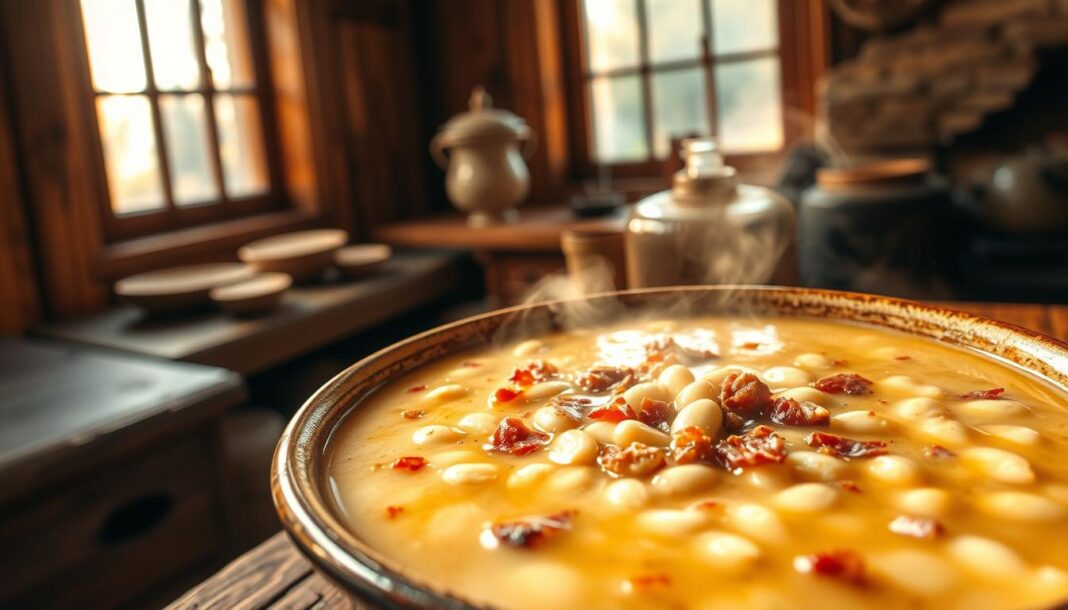In Frank Herbert’s seminal science fiction novel, the spice melange is the linchpin of the Dune universe, a complex and intricate world where this rare substance is the key to extended life, heightened awareness, and greater vitality.
As we explore the concept of melange, it becomes clear that this fictional drug is not only a literal commodity but also a metaphorical device, representing power, addiction, and ecological dependence within the narrative.
We will examine the multifaceted nature of spice as a substance that has captivated audiences across various adaptations, from books to films, and explore its far-reaching implications for the universe of Dune.
The Essence of Melange: What is Dune Spice?
In the vast expanse of the Dune universe, melange stands out as a substance of paramount importance, found only on the harsh desert planet of Arrakis. This rare and precious substance, commonly known as Dune spice, is intricately linked to the ecosystem of Arrakis, a planet characterized by its extreme desert conditions.
Definition and Basic Properties
Melange, or Dune spice, is defined by its unique transformation process. According to Frank Herbert, the pre-spice mass becomes melange “after exposure to sun and air.” This process underscores the substance’s dependence on the specific environmental conditions of Arrakis. As a commodity, melange is highly valued across the universe for its rarity and exclusive properties.
| Property | Description |
|---|---|
| Source | Sands of Arrakis (Dune) |
| Formation | Pre-spice mass exposed to sun and air |
| Color | Violet (as seen in “Children of Dune”) |
The Cinnamon-Like Substance of Arrakis
The melange is often described as having a cinnamon-like aroma and taste, making it immediately recognizable. This distinctive characteristic is a result of the harsh desert conditions on Arrakis, which contribute to the formation and properties of the spice. The spice is not only a valuable resource but also a crucial element in the ecosystem and economy of the Dune universe.
We will explore how the unique environment of Arrakis gives rise to this precious substance and its significance as a commodity in the interstellar economy. The monopoly on spice production makes Arrakis, a seemingly inhospitable desert planet, strategically important.
Origin and Production of Spice
The production of melange, known as Dune spice, is a complex process deeply intertwined with the ecology of the desert planet Arrakis. This intricate relationship is crucial for understanding how this valuable substance is harvested.
The Sandworm Life Cycle
The life cycle of the giant sandworms, which can grow up to 400 meters in length, is pivotal to the production of melange. These creatures roam the desert surface of Arrakis, playing a crucial role in the ecosystem. As they move through the sand, they release melange, making it available for collection. The sandworms’ life cycle, from larvae to massive adults, is closely tied to the spice’s production and distribution across the planet.
- The larvae stage is crucial as it burrows through the sand, releasing enzymes that help to create the melange.
- As the sandworms mature, they become capable of producing larger quantities of melange.
- Their massive size and mobility ensure the spice is distributed across the desert surface.
Harvesting Methods and Dangers
Harvesting melange is a hazardous operation due to the presence of giant sandworms. The mining process involves using a harvester to collect the spice from the surface. However, the rhythmic activity of this equipment attracts the sandworms, posing a significant threat to the harvesting crews. To mitigate this risk, a carryall aircraft is used to lift the harvester to safety when a sandworm approaches. The Fremen, native to Arrakis, have developed a more sustainable method of harvesting, manually collecting the spice and avoiding the dangers associated with industrial mining operations.
The Remarkable Effects of Spice Consumption
In the Dune universe, the spice melange is not just a valuable commodity but also a substance with remarkable effects on human physiology and cognition. The consumption of melange is associated with various benefits, ranging from physical transformations to enhanced mental capabilities and improved health.
Physical Transformations: The Blue Eyes of Ibad
One of the most noticeable physical effects of long-term melange consumption is the transformation of eye color to a deep blue, a characteristic known as “Ibad” or “blue-eyed.” This change is indicative of the body’s adaptation to the spice and is often seen in those who have consumed melange over an extended period. As Alia notes in Children of Dune, the spice has profound effects on the human body, making it a highly sought-after substance.
Mental and Cognitive Enhancements
Melange consumption is also linked to significant mental and cognitive enhancements. Users experience heightened awareness, improved concentration, and enhanced cognitive functions. These effects are crucial for individuals like the Bene Gesserit and Spacing Guild Navigators, who rely on their advanced cognitive abilities to perform their duties. The spice enables them to navigate complex mental landscapes and predict future events with greater accuracy.
Longevity and Health Benefits
The most significant benefit of melange consumption is its ability to extend human lifespan and improve overall health. Regular consumption of the spice can multiply human lifespan by several factors, providing users with greater vitality and protection against diseases. As mentioned in the Dune series, “Without melange and its amplification of the human immunogenic system, life expectancy for the very rich degenerated by a factor of at least four.” This makes melange a critical component of the health and wellbeing of those who can afford it, creating a dependency that shapes the social structure of the Dune universe. For more information on the spice and its significance, visit Historical Foods.
Spice as the Foundation of Interstellar Society
Spice melange is not just a valuable commodity; it’s the foundation upon which the interstellar society is built in the Dune series. The rarity and necessity of melange for interstellar travel make it a crucial element in the political and economic fabric of the universe.

The Guild Navigators and Space Travel
The Spacing Guild, with its Navigators who consume melange to foresee safe paths through space-time, holds a monopoly on interstellar travel. This monopoly is only possible due to the spice melange, which enhances the Navigators’ abilities to traverse the vast distances between stars. The reliance on melange for space travel underscores its importance in maintaining the interconnectedness of the universe.
Political and Economic Power of Spice Control
Control of the spice melange translates directly into political power. The ruler of Arrakis, the sole planet where melange is found, wields significant influence over the balance of power. Paul Atreides’ seizure of Arrakis exemplifies how control of spice production can reshape the power structure, making him a dominant force in the interstellar world. This control enables a form of “hydraulic despotism,” where dominance over a vital resource equates to absolute authority.
The Cultural and Spiritual Significance of Melange
Melange, or spice melange, plays a crucial role not only in the economy and politics of the Dune universe but also in its cultural and spiritual fabric. The substance is deeply intertwined with the identities and practices of various groups, including the Fremen and the Bene Gesserit.
The Fremen Relationship with Spice
The Fremen, native to the desert planet Arrakis, have a profound spiritual connection with melange, which they consider sacred. Their culture and rituals revolve around the sandworm life cycle, from which the spice is derived. The Fremen believe that the worm is a manifestation of the divine, and their careful harvesting of melange is a form of reverence. This deep connection is reflected in their ecological awareness and their ability to live in harmony with the harsh environment of Arrakis.
The Bene Gesserit and the Water of Life
The Bene Gesserit sisterhood utilizes spice melange and its derivative, the Water of Life—a worm byproduct—to enhance their psychic abilities and access prescience. During the ritual known as “the agony,” Bene Gesserit candidates ingest the Water of Life, undergoing a potentially fatal transformation that allows them to become Reverend Mothers, inheriting the memories of their ancestors. This process highlights the Bene Gesserit’s sophisticated understanding of spice as both a physical substance and a tool for expanding consciousness.
| Group | Significance of Melange | Key Practices |
|---|---|---|
| Fremen | Sacred substance, central to their spiritual and cultural identity | Rituals around sandworm life cycle, careful harvesting |
| Bene Gesserit | Tool for psychic powers, prescience, and genetic memory access | Ingestion of Water of Life, the agony ritual |
The Ecological Impact and Future of Spice
The ecological impact of spice harvesting on Arrakis is a critical theme in Frank Herbert’s Dune series. The spice, or melange, is harvested industrially on Arrakis by enormous mining machines, which could lead to devastating effects on the planet’s ecology if overexploited.
According to Werner, a worm expert, depleting the spice could result in losing the sandworm larvae, which in turn would lead to the loss of giant sandworms. These sandworms are crucial as they produce a significant amount of the planet’s oxygen, and their loss could cause the ecosystem to collapse.
The situation on Arrakis mirrors our real-world ecological concerns, as noted by Villa. To avoid ecological disaster, groups dependent on spice must manage it cooperatively. The complex relationship between spice, sandworms, and human society is central to Herbert’s ecological message, highlighting the need for sustainable practices in resource management.
The future of spice and the ecosystem of Arrakis hangs in the balance, emphasizing the importance of balancing consumption needs with long-term ecological sustainability.


